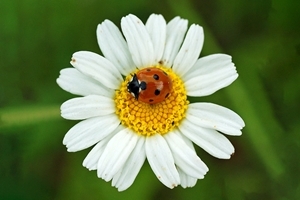Seven-spot ladybird
 The most abundant British ladybird is the seven-spot (Coccinella septempunctata), so called because it has seven black spots on a bright red background. There are around 3,500 species of ladybird worldwide, but until recently only 43 were considered as resident in Britain.
The most abundant British ladybird is the seven-spot (Coccinella septempunctata), so called because it has seven black spots on a bright red background. There are around 3,500 species of ladybird worldwide, but until recently only 43 were considered as resident in Britain.
I say “until recently”, as it now seems that we are gaining new species, which are colonising the UK. Recent arrivals are the well-known, multi-coloured harlequin ladybird (first appearing in 2004), which is now abundant, and also the far less obvious bryony ladybird (Epilachna argus), which has recently moved into southern England from the continent.
If you were to ask a person to name some species that over-winter in a dormant state as an adult, the chances are that the answer would include the usual suspects, such as the hedgehog, bat species and dormice. But of course, many insect species over-winter as adults too, and the seven-spot is one of them.
Between October and February, adult ladybirds will often gather in large groups, clustered together in cool places such as church windows, outbuildings, cracks in walls, holes in trees and even in the hollow stems of dead hogweed.
During March or April, the adults become active and leave their over-wintering sites to find aphids to eat. Come May, the ladybirds will mate, and over the next couple of months the females lay bright yellow eggs in batches of 10 to 50. After only about a week, the eggs hatch and the larvae voraciously feed on aphids for the following three or four weeks, each larva consuming around 500 aphids.
Pupation only lasts a matter of days before the adult ladybird emerges and once again starts to feed on aphids, consuming up to 4,500. So in its lifetime, a ladybird can eat around 5,000 aphids! You can now begin to understand why gardeners and farmers alike are happy to see good numbers of ladybirds amongst their crops and flowers!
The name ladybird, referring to ‘Our Lady the Virgin Mary’, comes from the seven-spot’s colouring: the red represents her cloak, which was usually shown as red in early paintings, and the seven black spots were thought to represent her seven joys and seven sorrows.
The bright colours of many ladybirds help to warn potential predators of their distastefulness, and they will also exude a yellow substance when attacked, which is rich in toxic alkaloids. Although this will put many predators off, some birds such as swifts and swallows, which feed on the wing, are immune to the defensive chemicals of ladybirds.
When summer conditions are suitable, large numbers of ladybirds can fly across the channel from the continent to boost the numbers of our home-grown ladybirds. I remember being on the north coast of Norfolk in the 1980s during a particularly hot spell, when ladybirds started to fly in off the sea. After a while they became so numerous that they completely cleared the beaches of sunbathers, many families running for the safety of their cars to get way from the “biting hordes of red devils” as the papers described the incident the next day!
Peter Thompson
Advisory
Read more from Peter Thompson at his blog.

Download Peter Thompson's essential 26-page book, featuring beautiful photography and detailed profiles of Britain's wildlife
Download FREE >